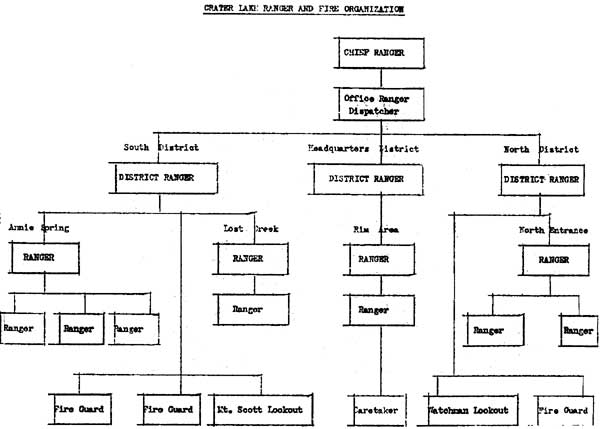Temporary checking kiosks were placed in the center of the road at the east and north entrances during 1942. The kiosks proved to be “highly satisfactory, facilitating checking operations a hundredfold, and providing a safe and convenient place for ranger records and files.” Leavitt desired similar kiosks at the south and west entrances as the existing Annie Spring station serving those entrances was “unsatisfactory for proper control, orientation, and direction of visitors.” [21] (See the below for a copy of the “Crater Lake Ranger and Fire Organization.”)

Crater Lake was operated on a bare maintenance level during the war as a result of reduced park appropriations and personnel . Park rangers performed a variety of untraditional tasks during the war emergency in addition to their principal responsibilities for fire protection and safeguarding of government property. In June 1943 Superintendent Leavitt reported that the chief ranger and the park naturalist undertook the major responsibility for trail repair and other maintenance work and furnished crews to assist the park carpenter, plumber, road foreman, and engineer in their duties. Leavitt noted:
. . . Without this fine spirit of loyalty among the more experienced and trained personnel, we would have accomplished very little, as the only unskilled labor we were able to procure was a few young boys just old enough to qualify under the age regulations, and a few old men.
The administrative heads of Crater Lake feel moved to praise and compliment the entire force for their unselfishness, loyalty to the Service and fine spirit as evidenced by the willingness to do anything and everything they could, and for the energy displayed in every department. The accomplishments with a minimum force were remarkable. To see a group of rangers and ranger naturalists in work clothes toiling at cleaning up large rock slides and fallen trees from the roads and trails, the rangers moving and rebuilding a boat house, and doing many other tasks calling for hard physical labor as well as skill and ingenuity, is convincing proof of the superiority of the Crater Lake staff, for every one did all he could to carry on with a willing and cheerful spirit. [23]
Fire protection was the primary concern of the park ranger force during the war. The park master plan in February 1944 indicated that fire protection personnel consisted of the chief ranger, one park ranger, two seasonal fire guards, two seasonal fire lookouts, and seven seasonal rangers. As outlined in the master plan the duties of the protection organization related almost entirely to fire prevention and control. The responsibilities were:
Recruiting, training and directing of fire protection personnel; supply and maintenance of lookouts; requisition, maintenance and use of fire tools and equipment; prevention education; fire hazard reduction; fire detection, suppression and fire studies. [24]
The park, which had been closed during the winter months throughout the war years, resumed regular year-round operations on June 15, 1946. Chief Ranger Crouch and a small staff of temporary rangers were on duty in the park several days before the official opening By June 30, however, a staff of twelve temporary rangers and six fire control aides were working. Checking incoming park visitors was resumed with the opening of the park, and temporary checking stands were built at the south and west entrances. Checking at the park boundaries was found “to be highly advantageous,” and the traffic jams, common when cars from both entrances were checked at Annie Spring, were eliminated. Regional Forester Burnett Sanford arrived at Crater Lake on June 30 and took part in the three-day ranger and fire training school for park rangers and fire control aides that had been resumed by Crouch.

